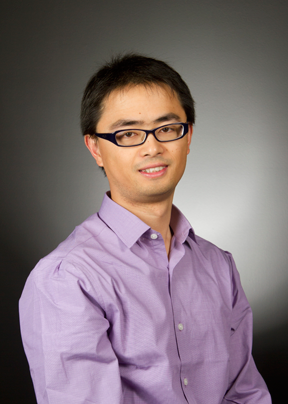 All are invited to attend the visiting scholar seminar Thursday, September 4, at 3:00 pm in WEB 1230 entitled,
All are invited to attend the visiting scholar seminar Thursday, September 4, at 3:00 pm in WEB 1230 entitled,
“Enhancing Solar Energy Harvesting and Conversion with Nano-Engineered Metamaterials”
Liping Wang, Ph.D.
Assistant Professor
Mechanical and Aerospace Engineering School for Engineering of Matter, Transport & Energy
Arizona State University, Tempe, AZ
Thursday, September 4, 2014
3:00 P.M.
Warnock Engineering Bldg. (WEB) 1230
Abstract:
Spectral control of thermal absorption and emission with engineered surface radiative properties plays a crucial role in harvesting solar energy. In this talk, I will discuss the exotic optical and radiative properties of nano-engineered materials, or called metamaterials, and how the novel metamaterials would greatly impact the performance of solar thermal, solar thermophotovoltaic (TPV), and solar photovoltaic energy conversion. By exciting magnetic polariton (MP), i.e., the coupling of electromagnetic waves to magnetic resonance inside nanostructures, film-coupled metamaterials made of tungsten gratings are successfully designed to achieve spectrally-selective absorption. The underlying physical mechanism and unique optical properties as a function of wavelength, direction, and polarization will be discussed in detail. An optimized metamaterial structure is numerically demonstrated as a perfect selective solar thermal absorber with >88% solar absorptance and <3% mid-IR emittance. The solar-to-heat conversion efficiency is theoretically predicted at different working temperatures and optical concentrations, demonstrating the enhanced performance with this superior metamaterial selective absorber. Recent temperature-dependent optical characterization results of a fabricated metamaterial solar absorber sample at room temperature up to 350°C will be presented. Besides, such a metamaterial absorber could be readily used as a selective TPV emitter at high temperatures. By using the designed metamaterial as the selective solar absorber, which efficiently converts solar energy to heat, and as the selective TPV emitter, which gives photons with energy only above the bandgap of a photovoltaic cell, the performance of a solar TPV system could be greatly enhanced. The estimated solar-to-electron efficiency for a metamaterial-enhanced solar TPV system could reach 10% with 50× optical concentration at an absorber-emitter temperature of 1200 K, far exceeding the 0.5% conversion efficiency with black surfaces. Finally, a film-coupled metamaterial solar cell is proposed with an ultrathin active semiconductor layer with thickness less than 100 nm. Plasmonic light trapping due to the excitation of MP, which strongly localizes light inside the active layer above the semiconductor bandgap, is achieved, leading to enhanced optical absorption in ultrathin solar cells and thus potentially improved electric power generation.
Bio:
Dr. Liping Wang received his Ph.D. in mechanical engineering with a focus on nanoscale radiative heat transfer in December 2011 at Georgia Institute of Technology under the guidance of Professor Zhuomin Zhang. He started his academic career as an assistant professor at Arizona State University in July 2012 after a short stay in Prof. Zhang’s group as a postdoctoral fellow. Dr. Wang’s research primarily aims to selectively control thermal radiation for energy and sensing applications by fundamentally understanding and exploring novel physical mechanisms in nanoscale radiative transport with nanoengineered materials or so-called metamaterials. Besides, he has been investigating near-field thermal radiation for energy harvesting and thermal modulation applications. Dr. Wang is currently the director of the Nano-Engineered Thermal Radiation Lab and the lead principal investigator for ASU’s participation in the US-Australia Solar Energy Collaboration on Micro Urban Solar Integrated Concentrator project, sponsored by Australian Renewable Energy Agency. His research findings have been published in more than 20 peer-reviewed high-impact journal papers in applied physics, optics, and heat transfer. He is the recipient of the 2010 Hartnett-Irvine Best Paper Award from the International Centre of Heat and Mass Transfer, and the 2011 ASME NanoEngineering Council Award for Top NanoEngineering in Energy & Sustainability Poster. Dr. Wang has won the 2013 Top 5% Engineering Faculty Teaching Award at ASU for his teaching excellence. Besides, he has been actively contributing to the professional community with service activities in organizing technical conferences and reviewing scientific manuscripts.